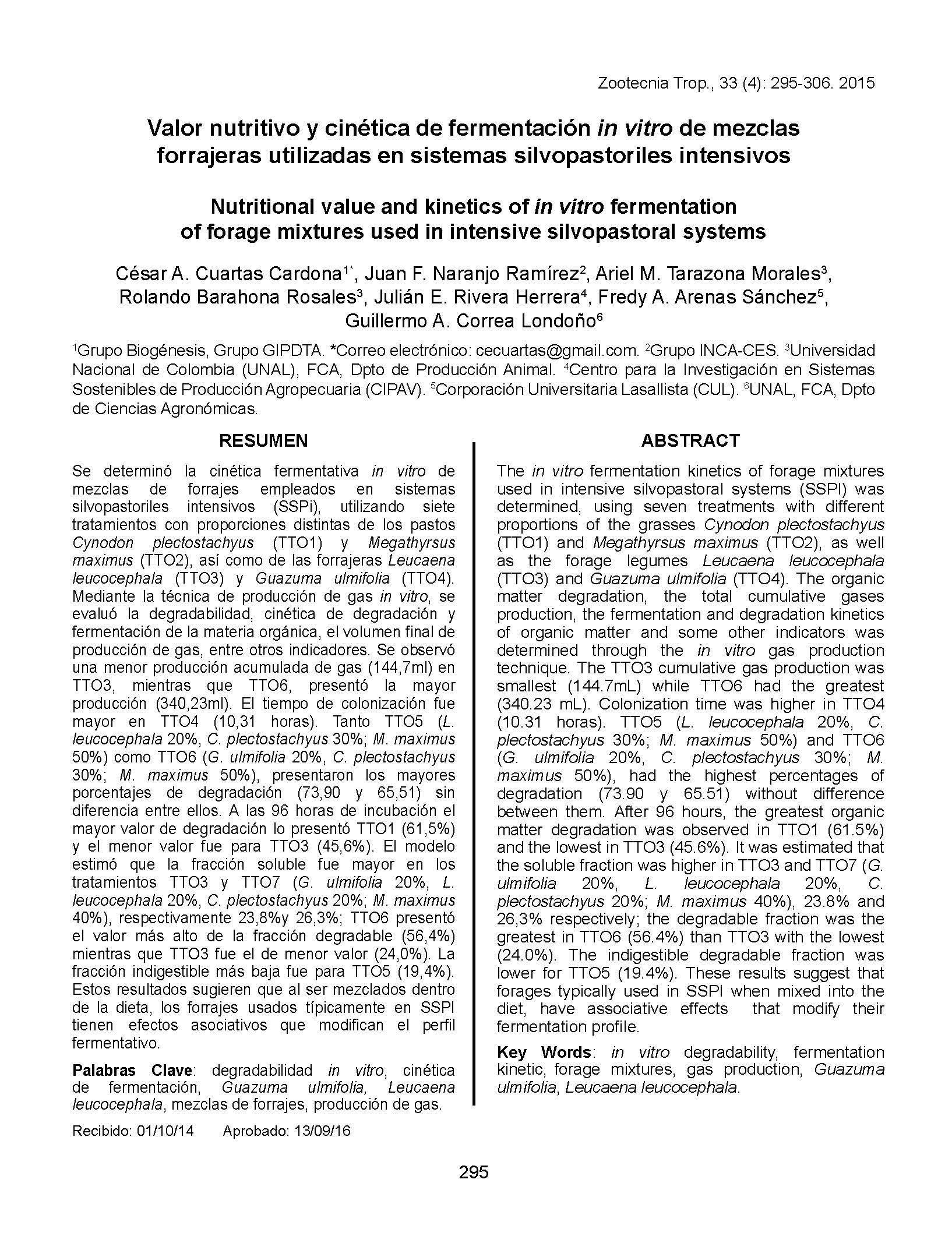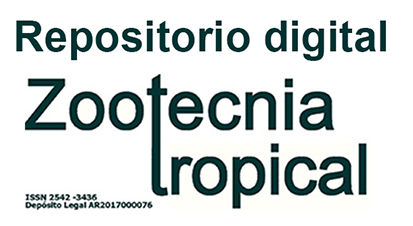Valor nutritivo y cinética de fermentación in vitro de mezclas forrajeras utilizadas en sistemas silvopastoriles intensivos
Resumen
Se determinó la cinética fermentativa in vitro de mezclas de forrajes empleados en sistemas silvopastoriles intensivos (SSPi), utilizando siete tratamientos con proporciones distintas de los pastos Cynodon plectostachyus (TTO1) y Megathyrsus maximus (TTO2), así como de las forrajeras Leucaena leucocephala (TTO3) y Guazuma ulmifolia (TTO4). Mediante la técnica de producción de gas in vitro, se evaluó la degradabilidad, cinética de degradación y fermentación de la materia orgánica, el volumen final de producción de gas, entre otros indicadores. Se observó una menor producción acumulada de gas (144,7ml) en TTO3, mientras que TTO6, presentó la mayor producción (340,23ml). El tiempo de colonización fue mayor en TTO4 (10,31 horas). Tanto TTO5 (L. leucocephala 20%, C. plectostachyus 30%; M. maximus 50%) como TTO6 (G. ulmifolia 20%, C. plectostachyus 30%; M. maximus 50%), presentaron los mayores porcentajes de degradación (73,90 y 65,51) sin diferencia entre ellos. A las 96 horas de incubación el mayor valor de degradación lo presentó TTO1 (61,5%) y el menor valor fue para TTO3 (45,6%). El modelo estimó que la fracción soluble fue mayor en los tratamientos TTO3 y TTO7 (G. ulmifolia 20%, L. leucocephala 20%, C. plectostachyus 20%; M. maximus 40%), respectivamente 23,8%y 26,3%; TTO6 presentó el valor más alto de la fracción degradable (56,4%) mientras que TTO3 fue el de menor valor (24,0%). La fracción indigestible más baja fue para TTO5 (19,4%). Estos resultados sugieren que al ser mezclados dentro de la dieta, los forrajes usados típicamente en SSPI tienen efectos asociativos que modifican el perfil fermentativo.
Descargas
Citas
• Aumont, G., G. Saminadin, P. Cerneau and A. Xandé. 1994. Effects of sample preparation on nitrogen degradability of pangola grass (Digitaria decumbens) and tropical tree legumes. J. Agr. Sci., 123:47-54. Disponible en línea: http://bit.ly/32h3Zy5 [Oct. 19, 2016].
• Barahona, R. y S. Sánchez. 2005. Limitaciones físicas y químicas de la digestibilidad de pastos tropicales y estrategias para aumentarla. Corpoica Cienc. Tec. Agro., 6:69-82.
• Barros, M., J. Solorio, J. Ku-Vera, A. Ayala, C. Sandoval and G. Solís. 2012. Productive performance and urinary excretion of mimosine metabolites by hair sheep grazing in a silvopastoral system with high densities of Leucaena leucocephala Trop. Anim. Health Prod., 44:1873-1878. Disponible en línea: http://bit.ly/2HSpb3L [Oct. 12, 2016].
• Blümmel, M., P. Bullerdieck. 1997. The need to complement in vitro gas production: measurements with residue determinations from in sacco degradabilities to improve the predictions of voluntary intake of hays. Anim. Sci. Prod., XX: pp. 71-75.
• Blümmel, M., H. P. Makkar and K. Becker. 1997. In vitro gas production: a technique revisited. J. Anim. Physiol. Anim. Nutr., 77: 24-34. Disponible en línea: http://bit.ly/2HOPAjb [Oct. 21, 2016].
• Blümmel, M., K. P. Aiple, H. Steingass and K. Becker, 1999. A note on the stoichiometrical relationship of short chain fatty acid production and gas evolution in vitro in feedstuffs of widely differing quality. J. Anim. Physiol. Anim. Nutr., 81:157–167. Disponible en línea: http://bit.ly/2HIUY7k [Oct. 23, 2016].
• Buchanan, J. G. and D. G. Fox. 2000. Feeding Systems for Beef Cattle. In: Theodorou, M. K and J. France (Eds.), Feeding Systems and Feed Evaluation Models. CABI Publishing, Oxfordshire, UK, pp. 129-154. Disponible en línea: http://bit.ly/38TLjXI [Oct. 16, 2016].
• Cuartas, C. A., J. F. Naranjo, A. M. Tarazona, G. A. Correa, R. Barahona-Rosales. 2015. Dry matter and nutrient intake and diet composition in Leucaena leucocephala – based intensive silvopastoral systems. Trop. Subtrop. Agroecosyst., 18: 303-311. Disponible en línea: http://bit.ly/2SOt2W4 [Oct. 29, 2016].
• Cuartas, C. A., J. F. Naranjo, A. M. Tarazona, E. Murgueitio, J. D. Chará, J. Ku, F. J. Solorio, M. X. Xotchil Flores, B. Solorio y R. Barahona. 2014. Contribution of intensive silvopastoral systems to animal performance and to adaptation and mitigation of climate change. Rev. Colomb. Cienc. Pecu., 27:76-94. Disponible en línea: http://bit.ly/2HNbsLH [Oct. 28,2016].
• Delgado, D. C., O. La O, B. Chongo, J. Galindo, Y. Obregón y A. I. Aldama. 2001. Cinética de la degradación ruminal in situ de cuatro árboles forrajeros tropicales: Leucaena leucocephala, Enterolobium cyclocarpum, Sapindus saponaria y Gliricidia sepium. Rev. Cub. Cienc. Agric., pp. 141-145.
• Estrada, J. M., A. Sandoval, L. Ramírez and C. M. Capetillo. 2009. In vitro fermentation efficiency of mixtures of Cynodon nlemfuensis, Leucaena leucocephala and two energy sources (maize or sugar cane molasses). Trop. Subtrop. Agroecosyst., 10:497-503. Disponible en línea: http://bit.ly/37Ti6uq [Oct. 15, 2016].
• Flores, O., D. Bolívar, J. Botero y M. Ibrahim. 1998. Parámetros nutricionales de algunas arbóreas leguminosas y no leguminosas con potencial forrajera para la suplementación de rumiantes en el trópico. Liv. Res. Rur. Dev., 10(1). Disponible en línea: http://bit.ly/38Sv7FR [Oct.14, 2016].
• Fondevila, M., J. C. Nogueira and A. Barrios. 2002. In vitro microbial fermentation and protein utilisation of tropical forage legumes grown during the dry season. Anim. Feed Sci. Tech., 95:1-14. Disponible en línea: http://bit.ly/32mWOV8 [Oct. 06,2016].
• Fox, D. G., C. J. Sniffen, J. D. O’Connor, J. B. Russell and P. J. Van Soest. 1992. A net carbohydrate and protein system for evaluating cattle diets: III. Cattle requirements and diet adequacy. J. Anim.Sci., 70. pp. 3578-3596. Disponible en línea: http://bit.ly/2HL8hEl [Oct. 08, 2016].
• France, J., E. Kebreab, J. France and E. Kebreab. 2008. Mathematical Modelling in Animal Nutrition. CABI, Oxfordshire, UK. pp. 1-11.
• France, J., M. K. Theodorou, R. S. Lowman and D. E. Beever. 1999. Feed Evaluation for Animal Production In: Theodorou M. K. And J. France (Eds). Feeding Systems and Feed Evaluation Models. CABI, Oxfordshire, UK. First Ed. pp. 1-9.
• France, J., M. S. Dhanoa, M. K. Theodorou, S. J. Lister, D. R. Davies and D. Isac. 1993. A model to interpret gas accumulation profiles associated with in vitro degradation of ruminant feeds. J. Theoretical Biol., 163:99-111. Disponible en línea: http://bit.ly/32tj7bP [Oct. 23, 2016].
• Gaviria-Uribe, X., J. F. Naranjo-Ramírez, D. M. Bolívar-Vergara,R. Barahona-Rosales. 2015. Consumo y digestibilidad de novillos cebuínos en un sistema silvopastoril intensivo. Arch. Zootec. 64:21- 27. Disponible en línea: http://bit.ly/32h53C5 [Oct. 22, 2016].
• Holdridge, L. R. 200. Ecología basada en zonas de vida. Instituto Interamericano de Cooperación para la Agricultura. San José, Costa Rica.
• Krizsan, S. J., F. Jančík, M. Ramin and P. Huhtanen. 2012. Comparison of some aspects of the in situ and in vitro methods in evaluation of NDF digestion. J. Anim. Sci., Disponible en línea: http://bit.ly/2uqeZN4 [Oct. 20, 2016].
• Leng, R. A. 1990. Factors affecting the utilization of “poor-quality” forages by ruminants particularly under tropical conditions. Nutr Res Reviews. 3 (1) pp. 277–303. Disponible en linea: http://bit.ly/2SPy9oL [Oct. 08, 2016].
• Leng, R. A. 1997. Tree Foliage in Ruminant Nutrition, FAO Animal Production and Health Paper 139. FAO, Rome, Italy.
• Licitra, G., T. M. Hernández and P. J. Van Soest. 1996. Standardization of procedures for nitrogen fractionation of ruminant feeds. Anim. Feed Sci. Technol., 57:347-358. Disponible en línea: http://bit.ly/32mXkT4 [Oct. 19, 2016].
• López, S., J. France, J. Dijkstra and M. S. Dhanoa. 2000. Models to interpret degradation profiles obtained from In Vitro and In: Situ incubation of ruminant feeds. McNamara J.P., J. France, D.E. Beever (Eds.), Modelling Nutrient Utilization in Farm Animals. CAB International, Wallingford UK, pp. 73-86.
• López, S., M. D. Carro, J. S. González and F. J. Ovejero. 1998. Comparison of different in vitro and in situ methods to estimate the extent and rate of degradation of hays in the rumen. Anim. Feed Sci. Technol. 73:99-113.
• Maasdorp, B. V. and B. H. Dzowela. 1998. Comparison of Leucaena leucocephala and other three fodders as supplements for lactating dairy cows. In: Shelton M., R.C. Gutteridge, B.F. Mullen and R.A. Bray. Leucaena. Adaptation, Quality and Farming Systems. Proceedings of a workshop held in Hanoi, Vietnam. pp. 291-293.
• Machado, P. A. S., S. C. Valadares Filho, R. F. D. Valadares, M. F. Paulino, P. V. R. Paulino and M. I. Marcondes. 2012. Desempenho e exigências de energia e proteína de bovinos de corte em pasto suplementados. Arq. Bras. Med. Vet. Zootec., 64 (3):683-692.
• Makkar, H. P. S. 2000. Applications of the in vitro gas method in the evaluation of feed resources, and enhancement of nutritional value of tannin-rich tree/browse leaves and agro-industrial by-products. Proceedings Meeting IAEA Technical Cooperation Regional AFRA Project. Cairo, Egypt, pp.23-40. Disponible: http://bit.ly/2HOKBPk [Oct. 23,2016].
• Makkar, H. P. S, M. Blümmel, K. Becker. 1998. Application of an in vitro gas method to understand the effects of natural plant products on availability and partitioning of nutrients. En: E. R Deaville, E. Owen, A. T. Adesogan, C. Rymer, J. A. Huntington, T. L. J. Lawrence (Eds.) In Vitro Techniques for Measuring Nutrient Supply to Ruminants, BSAS Occasional Publication No. 22:147-150.
• Mauricio, R. M., F. L. Mould, M. S. Dhanoa, E. Owen, K. S. Channa and M. K. Theodorou. 1999. A semi-automated In Vitro gas production technique for ruminant feedstuff evaluation. Anim. Feed Sci. Technol., 79:321-330. Disponible en línea: http://bit.ly/38SNYkd [Oct. 21, 2016].
• McDougall, E. I. 1948. Studies on ruminant saliva. 1. The composition and output of sheep’s saliva. J. Biochem., 43:99-109.
• Molina, I. C., G. V. Donneys, S. Montoya, J. Rivera, J. Chara, G. H. Villegas, R. Barahona 2015. La inclusión de Leucaena leucocephala reduce la producción de metano de terneras Lucerna alimentadas con Cynodon plectostachyus y Megathyrsus maximus. Liv. Res. Rur. Dev. Vol. 27. Disponible en línea: http://bit.ly/32g1bBe [Oct. 22, 2016].
• Monforte, G. E., C. A. Sandoval, L. Ramírez and C. M. Leal. 2005. Defaunating capacity of tropical fodder trees: Effects of polyethylene glycol and its relationship to in vitro gas production. Anim. FeedSci. Technol., 123-124: 313-327. Disponible en línea: http://bit.ly/32g1iNa [Oct. 16, 2016].
• Mota, M., R. Rodríguez, E. Solanas and M. Fondevila, 2005. Evaluation of four tropical browse legumes as nitrogen sources: Comparison of in vitro gas production with other methods to determine N degradability. Anim. Feed Sci. Technol., 123-124(1):341- 350. Disponible en línea: http://bit.ly/2STGg41 [Oct. 18, 2016].
• Naranjo, J. F., C. A. Cuartas y H. J. Correa. 2005. Comparación de cuatro modelos matemáticos para la caracterización de la cinética de degradación ruminal de algunos recursos forrajeros. Liv. Res. Rur. Dev. Vol. 17. Disponible en línea: http://bit.ly/2SQ0mfh [Oct. 25, 2016].
• Ngamsaeng, A., M. Wanapat, S. Khampa. 2006. Evaluation of local tropical plants by in vitro rumen fermentation and their effects on fermentation end-products. Pakistan J Nutr. 5: 414–418. Disponible en: http://bit.ly/37NDOjG [Oct. 25, 2016].
• Nogueira, J. C., M. Fondevila, A. Barrios and M. González. 2000. In vitro microbial fermentation of tropical grasses at an advanced maturity stage. Anim. Feed Sci. Technol., 83:145-157. Disponible en línea: http://bit.ly/2ukybvt [Oct. 20,2016].
• Nsahlai, I. V., N. N. Umunna and D. Negassa, 1995. The effect of multi-purpose tree digesta on in vitro gas production from napier grass or neutral-detergent fibre. J. Sci. Food Agr., 69:519–528.
• Ørskov, E. R. and I. McDonald. 1979. The estimation of protein degradability in the rumen from incubation measurements weighted according to rate of passage. J. Agr. Sci., 92:499-503.
• Paengkoum, P. and S. Traiyakun. 2011. Ruminal and intestinal digestibility of leucaena (Leucaena leucocephala) and jack fruit (Artocarpus heterophyllus) foliages using in sacco and three-step techniques. Res. J. Appl. Sci., 6(2):88-91. Disponible en línea: http://bit.ly/2umoXit [Oct.11,2016].
• Pell, A. N. and P. Schofield. 1993. Computerized monitoring of gas production to measure forage digestion in vitro. J. DairySci., 76:1063-1073. Disponible en línea: http://bit.ly/37WkzEI [Oct. 02, 2016].
• Posada, S. L. y R. Rosero. 2006. Comparación de modelos matemáticos: Una aplicación en la evaluación de alimentos para animales. Rev. Col. Cienc. Pec., 20:141-148. Disponible en línea: http://bit.ly/2vW4QYK [Oct. 14,2016].
• Razz, R., T. Clavero y J. Vergara. 2004. Cinética de degradación in situ de la Leucaena leucocephala y Panicum maximum. Rev. Cient., 14:424-430.
• Rodríguez, R., M. Fondevila and C. Castrillo. 2009. In vitro ruminal fermentation of Pennisetum purpureum CT-115 supplemented with four tropical browse legume species. Anim. Feed Sci. Technol., 151:65-74. Disponible en línea: http://bit.ly/37LJ9Yx [Oct. 19, 2016].
• Russell, J. B., J. D. O’Connor, D. G. Fox, P. J. Van Soest and C. J. Sniffen. 1992. A net carbohydrate and protein system for evaluating cattle diets: I. Ruminal fermentation. J. Anim. Sci., 70. pp. 3551-3561. Disponible en línea: http://bit.ly/32l2Oxj [Oct, 15. 2016].
• Sandoval, C. A., C. Capetillo, R. Cetina and L. Ramirez. 2002. A mixture simplex design to study associative effects with an in vitro gas production technique. Anim. Feed Sci. Technol., 101:191-200. Disponible en línea: http://bit.ly/32kxY8o [Oct. 15, 2016].
• SAS Institute Inc. 2008. SAS/STAT® 9.2 User’s Guide. Statistical Analysis Systems Institute, INC, Cary, NC, USA. Sniffen, C. J., J. D. O’Connor, P.J. Van Soest, D. G. Fox and J. B. Russell. 1992. A net carbohydrate and protein system for evaluating cattle diets: II. Carbohydrate and protein availability. J. Anim. Sci., 70:3562-3577.
• Tarazona, A. M., M. C. Ceballos, C. A. Cuartas, J. F. Naranjo, E. Murgueitio and R. Barahona. 2013. The relationship between nutritional status and bovine welfare associated to adoption of intensive silvopastoral systems in tropical conditions. In: Enhancing animal welfare and farmer income through strategic animal feeding - Some case studies (ed. Makkar H). pp. 69-78, FAO Animal Production and Health Paper No. 175. FAO, Rome, Italy.
• Theodorou, M. K., B. A. Williams, M. S. Dhanoa, A. B. McAllan and J. France. 1994. A simple gas production method using a pressure transducer to determine the fermentation kinetics of ruminant feeds. Anim. Feed Sci. Technol., 48:185-197. Disponible en línea: http://bit.ly/2vW5fue [Oct. 14,2016].
• Van, Soest P. J., J. B. Robertson and B. A. Lewis. 1991. Methods for dietary fiber, neutral detergent fiber, and nonstarch polysaccharides in relation to animal nutrition. J. Dairy Sci., 74:3583-3597.
• Vergara, J., Á. Rodríguez, C. Navarro y Á. Atencio. 2006. Efecto de la suplementación con leucaena (Leucaena leucocephala Lam. de Wit) sobre la degradabilidad ruminal del pasto alemán (Echinochloa polystachya h.b.k. Hitch). Rev. Cient.,16:642-647.
• Weimer, P. J. 1998. Manipulating ruminal fermentation: a microbial ecological perspective. J. Anim. Sci., 76:3114-3122. Disponible en línea: http://bit.ly/2SPC70H [Oct. 19,2016].
• Williams, B. A. 2000. Cumulative gas-production techniques for forage evaluation. In: Givens D. I., E. Owen, R. F. Axford and H. M. Omed (Eds.), Forage Evaluation In: Ruminant Nutrition. CABI, Oxfordshire, UK. pp. 189-213.

Derechos de autor 2015 César A. Cuartas Cardona, Juan F. Naranjo Ramírez, Ariel M. Tarazona Morales, Rolando Barahona Rosales, Julián E. Rivera Herrera, Fredy A. Arenas Sánchez, Guillermo A. Correa Londoño

Esta obra está bajo licencia internacional Creative Commons Reconocimiento-NoComercial-CompartirIgual 4.0.








